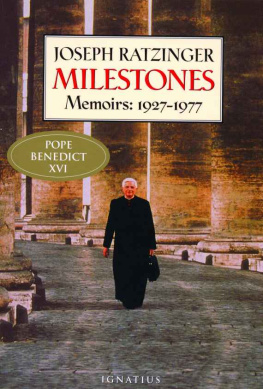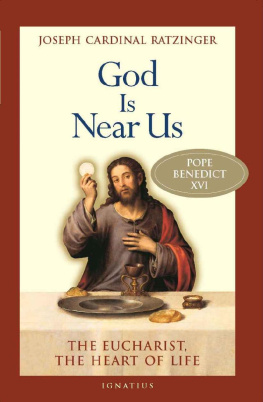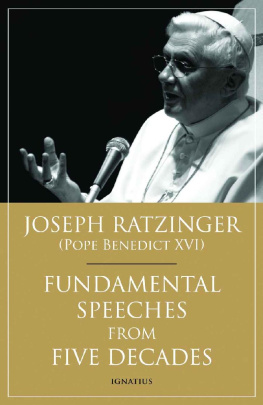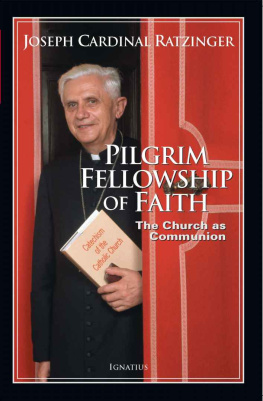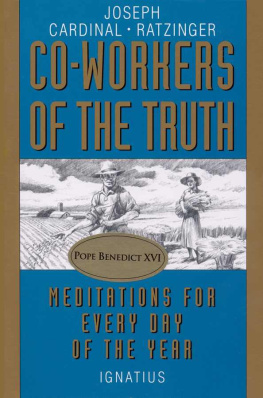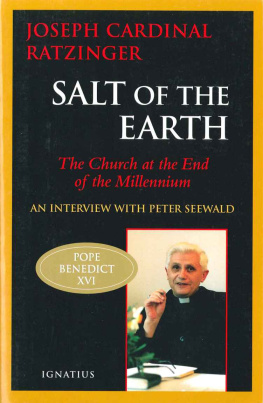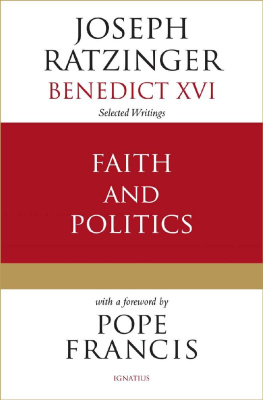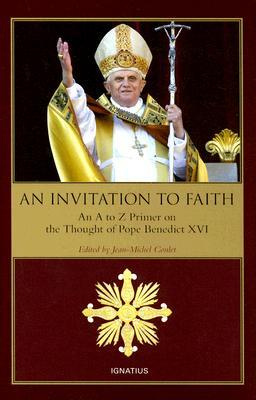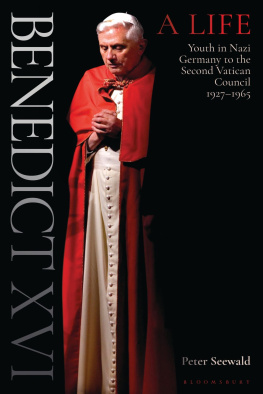MILESTONES
Joseph Cardinal Ratzinger
MILESTONES
Memoirs 1927-1977
TRANSLATED FROM THE GERMAN
BY
Erasmo Leiva-Merikakis
IGNATIUS PRESS SAN FRANCISCO
Title of the German edition:
Aus meinem Leben: Erinnerungen (1927-1977 )
1998 Deutsche Verlags-Anstalt, Stuttgart
Title of the Italian edition:
La mia vita: Ricordi (1927-1977 )
1997 Edizioni San Paolo, Milan
Rights to reproduce photographs
granted by Edizioni San Paolo
1998 Ignatius Press, San Francisco
All rights reserved
ISBN 978-0-89870-702-1
ISBN 0-89870-702-1
Library of Congress catalogue number 98-71929
Printed in the United States of America
Contents
Childhood between the Inn
and the Salzach Rivers
It is not at all easy to say what my hometown really is. As a rural policeman, my father was transferred frequently, so we were continually on the road. In 1937, however, when my father turned sixty and retired, we moved into the house in Hufschlag, outside Traunstein, and for the first time we had a real home. But even our previous moves occurred within a limited radiusin the triangle formed on two sides by the Inn and the Salzach rivers, whose landscape and history marked my youth. This had been an ancient land worked by the Celts, which then became a part of the Roman province of Raetia and always remained proud of its twofold cultural roots. Celtic artifacts have been discovered that point to a very ancient past and connect us with the Celtic world of Gaul and Britain. There are still fragments of Roman roads, and many places can refer to their former Latin names with pride in a longer history. Roman soldiers doubtless brought Christianity into the region already in pre-Constantinian times, and, even if the faith was largely buried in the chaos of the migration of peoples, streamlets of it were nonetheless able to continue flowing through this dark epoch, to be revitalized by the missionaries who afterward arrived from Gaul, Ireland, and England. Some experts even posit the existence of Byzantine influences. Salzburg (Roman Juvavum ) became a Christian metropolis that strongly determined the cultural history of this land down to the Napoleonic era. Virgil, the remarkably obstinate and rebellious bishop from Ireland, was a decisive personality, and even more so was Rupert, a native of Gaul, who is venerated here in a livelier way than Corbinian, the founder of the bishopric of Freising. This is explained by the fact that only after the Napoleonic Wars was the Bavarian portion of this land joined to the newly founded archbishopric of Munich-Freising. And, in speaking of this part of our ancient Christian history, we must not forget the Anglo-Saxon Boniface, who gave the whole of what was then Bavaria its ecclesial structure.
I was born on Holy Saturday, April 16, 1927, in Marktl am Inn. The fact that my day of birth was the last day of Holy Week and the eve of Easter has always been noted in our family history. This was connected with the fact that I was baptized immediately on the morning of the day I was born with the water that had just been blessed. (At that time the solemn Easter Vigil was celebrated on the morning of Holy Saturday.) To be the first person baptized with the new water was seen as a significant act of Providence. I have always been filled with thanksgiving for having had my life immersed in this way in the Easter mystery, since this could only be a sign of blessing. To be sure, it was not Easter Sunday but Holy Saturday, but, the more I reflect on it, the more this seems to be fitting for the nature of our human life: we are still awaiting Easter; we are not yet standing in the full light but walking toward it full of trust.
Since we left Marktl in 1929, barely two years after my birth, I have no real memory of it, only the stories of my parents and of my brother and sister. They have told me of the deep snow and teeth-clattering cold that reigned on the day of my birth. My two older siblings to their great chagrin could not come to my christening because of the danger of catching cold. The time the family spent in Marktl was not an easy one: unemployment was rife; war reparations weighed heavily on the German economy; battles among the political parties set people against one another; endless illnesses visited the family. But there were also many beautiful memories of friendship and neighborly aid, memories of small family celebrations and of church life. And I must not forget to note that Marktl is very close to Altotting, the venerable and ancient Marian shrine dating from the Carolingian era, which since the late Middle Ages has become the great pilgrimage site for Bavaria and western Austria. Just in those years Altotting received new renown with the beatification and then the canonization of Brother Konrad of Parzham (1818-1894), a Capuchin who had been porter of his monastery. In this humble and thoroughly kind man we saw what is best in our people embodied and led by faith to its most beautiful possibilities. I have often reflected since then on this remarkable disposition of Providence: that, in this century of progress and faith in science, the Church should have found herself represented most clearly in very simple people, in a Bernadette of Lourdes, for instance, or even in a Brother Konrad, who hardly seemed to be touched by the currents of the time. Is this a sign that the Church has lost her power to shape culture and can take root only outside the real current of history? Or is it a sign that the clear view of the essential, which is so often lacking in the wise and prudent (see Mt 11:25), is given in our days, too, to little ones? I do think that precisely these little saints are a great sign to our time, a sign that moves me ever more deeply, the more I live with and in our time.
But back to my childhood. The second stop on our journey was Tittmoning, the small town on the Salzach River whose bridge constitutes the border with Austria. With an architecture heavily marked by the Salzburg style, Tittmoning remains my childhoods land of dreams. There is the big, even majestic, town square with its noble fountain, bordered by the Laufen and Burghausen Gates, surrounded by the proud old houses of burgherstruly a square that would do great honor to bigger cities. Above all, the shop windows illuminated at night during the Christmas season have remained in my memory like a wonderful promise. It was in Tittmoning that Bartholomew Holzhauser wrote down his apocalyptic visions at the time of the Thirty Years War. But his greatest merit was to have picked up and revived the idea (going back to Eusebius of Vercelli and Saint Augustine) of having secular priests live together in community. The religious house, or Stift , that he founded in this small city on the Salzach left behind certain titles: the pastor was called Stiftsdekan (dean of the Stift ), and the parochial vicars were called canons. As was the custom in canonry churches, the Blessed Sacrament was reserved in a separate chapel and not in the tabernacle on the high altar. All of this gave us the feeling that our little city in every respect had something special about it. This could also be seen in the fact that the rectory was enthroned like a small castle on an elevation high above the town. Most of all, however, we loved the beautiful old Baroque monastic church that had once belonged to the Augustinian canons and was now lovingly looked after by the English Sisters. The girls school and the kindergarten (then called childrens establishment) were now housed in the old monastic buildings. What my memory recalls most sharply is the Holy Sepulcher, with many flowers and colorful lights, that would be set up in this church between Good Friday and Easter and that, before any rational comprehension, brought home the mystery of death and resurrection to both my exterior and interior senses.
Next page
